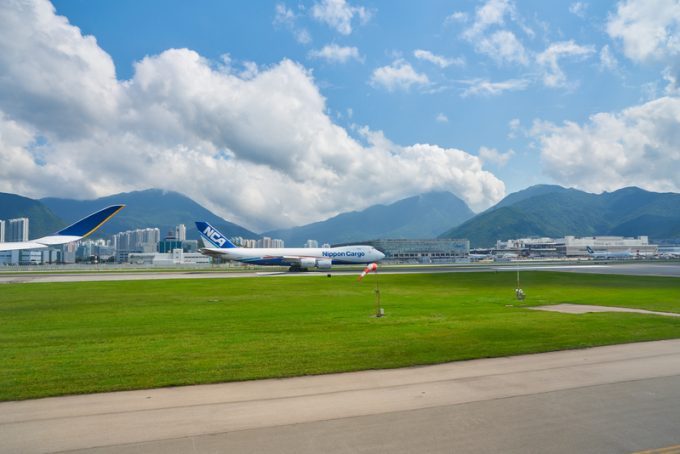'Last chance' for US importers to stock up before possible east coast port strike
The lead time for Chinese exports to the US east coast is still just over ...
TFII: SOLID AS USUALMAERSK: WEAKENINGF: FALLING OFF A CLIFFAAPL: 'BOTTLENECK IN MAINLAND CHINA'AAPL: CHINA TRENDSDHL: GROWTH CAPEXR: ANOTHER SOLID DELIVERYMFT: HERE COMES THE FALLDSV: LOOK AT SCHENKER PERFORMANCEUPS: A WAVE OF DOWNGRADES DSV: BARGAIN BINKNX: EARNINGS OUTODFL: RISING AND FALLING AND THEN RISING
TFII: SOLID AS USUALMAERSK: WEAKENINGF: FALLING OFF A CLIFFAAPL: 'BOTTLENECK IN MAINLAND CHINA'AAPL: CHINA TRENDSDHL: GROWTH CAPEXR: ANOTHER SOLID DELIVERYMFT: HERE COMES THE FALLDSV: LOOK AT SCHENKER PERFORMANCEUPS: A WAVE OF DOWNGRADES DSV: BARGAIN BINKNX: EARNINGS OUTODFL: RISING AND FALLING AND THEN RISING

The launch of Hong Kong’s new x-ray screening rule for air cargo has been delayed due to concerns over the city’s ailing economy and potential supply chain disruption.
Last week, the Civil Aviation Department (CAD) announced that the phased implementation of the International Civil Aviation Organisation (ICAO) security requirement – starting with 25% screening of all shipments – would be pushed back from November until January 2020.
“The government fully appreciates the industry’s strong demand to boost the export air cargo throughput towards the end of this year, especially noting the sharp decline in air cargo throughput in the first half of 2019,” CAD said.
“In the light of the latest situation of the Hong Kong economy of which the air cargo industry plays a significant role, and in view of recent feedback received from the industry, the CAD adjusted the transitional arrangement.
“This would allow the air cargo industry more time to cope with the enhanced security screening requirements amidst the economic challenges the industry is facing.”
The delay was welcomed by Hong Kong’s shippers and forwarders, including Neel Jones Shah, global head of airfreight at Flexport.
“In my view this reflects that Hong Kong realised the community isn’t prepared yet,” he told The Loadstar. “And rather than have HKIA [airport] become a massive bottleneck, they wisely decided to push the schedule out a bit.”
As it stands, the requirement will be gradually increased until June 2021, when 100% shipment screening will be enforced.
Mr Shah added: “Regardless of the deadline, the x-ray screening requirement will have an impact on Hong Kong warehousing operations. All regulated agents will have to change their processes to accommodate in-house screening.
“When Flexport moved into its new facility this summer, we did a complete process redesign because we knew we’d need to accommodate it.”
The new facility doubled Flexport’s warehousing capacity in Hong Kong. Mr Shah said the forwarder received its x-ray scanner yesterday, and would have it installed before the end of the month, putting the company “almost two years ahead of the curve”.
Hong Kong is the world’s largest air cargo hub, handling 5.1m tonnes last year. However, there are reportedly only seven in-house screening facilities so far approved by CAD out of 110 applications. Local forwarder U-Freight announced this week it was “one of the first” forwarders to have its facility certified.
With only a tiny fraction of cargo currently screened at HKIA, there are fears the airport could lose a key advantage over regional competitors, since cargo cut–off times could be increased in line with mainland China, where there is already 100% screening.
“Delay of the implementation of Phase 1 x-ray scanning to January is the right decision,” reckoned Sunny Ho, executive director at the Hong Kong Shippers’ Council.
“We’re not underestimating the impact of x-ray scanning, when it requires a substantial change in processes and additional costs. No such change is required for our neighbouring competitors, as 100% scanning is already practiced there.”
The enforcement delay highlights a challenging time for Hong Kong’s air cargo industry and the city’s economy, which is still reeling from ongoing protests against the government.
HKIA reported a year-on-year drop of 11.5% to 382,000 tonnes in August, while total throughput for the first eight months of 2019 is down 7.4% to 3.08m tonnes compared with the same period last year.
Comment on this article